
Features
Structural
Training
Back to Basics: August 2010
We have been looking at several aspects of ground ladders and how they are effective on the fire ground. In June we reviewed ladder placement angles and how we can ladder a building quickly for rescue without having to check for a proper angle.
August 10, 2010
By Mark van der Feyst
We have been looking at several aspects of ground ladders and how they are effective on the fire ground. In June we reviewed ladder placement angles and how we can ladder a building quickly for rescue without having to check for a proper angle.
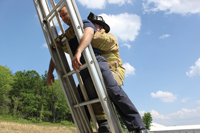 |
|
| Photo 1: The first rescue method is to have the victim face the ladder with his back toward the rescuer. Photos by Mark van der Feyst |
|
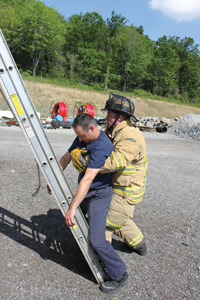 |
|
| Photo 2: The rescuer is able to take his hands off the rungs of the ladder. |
|
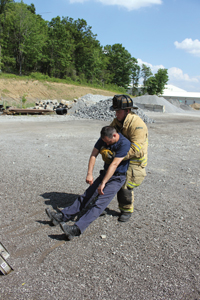
|
|
| Photo 3: The rescuer grabs the victim under the arms to drag him away. Advertisement
|
|
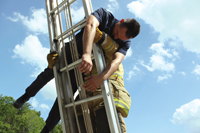 |
|
| Photo 4: The other method for rescuing a fire victim is to position the victim horizontally across your arms. |
|
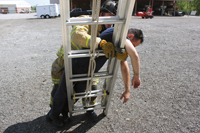 |
|
| Photo 5: The victim’s feet have been placed on the ground but the upper part of the body is still being supported by the left arm of the rescuer. |
|
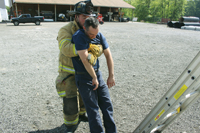 |
|
| Photo 6: The rescuer drags the victim away from the ladder using the upper body drag technique. |
We train to rescue civilians from buildings but we seldom have an opportunity to do so. In bigger cities, this opportunity may occur more often than in smaller municipalities. As mentioned in earlier columns, one firefighter with a 24-foot or 28-foot ground ladder can be very effective on the fire ground, especially when rescuing civilians.
Rescuing a conscious civilian may not be that physically taxing but it will be challenging mentally. Conscious fire victims may be hysterical, panic stricken or calm. If they are hysterical or panic stricken, rescuers must take control. Taking control requires rescuers get the attention of the victim and to have him focus on you as you provide directions. Hysterical and panic-stricken fire victims can be dangerous for rescuers. If not controlled quickly, they will take the rescuer for a dangerous ride straight down to the ground.
Rescuing unconscious fire victims requires physical effort. Here we will look at the phase during which the victim is out the window and on the ladder. In September, we focus on getting the fire victim from the floor to the window.
The first method rescuers can use to remove or rescue a fire victim is to have the victim face the ladder with his back toward the rescuer. This requires the victim’s feet to be passed out first and his body to be properly oriented. This takes time to set up and, in a situation in which rescuers will need to get the fire victim out of the structure, will not be the preferred method.
Once the fire victim is on the ladder, the firefighter needs to have his hands and arms underneath the victim’s armpits and one knee positioned underneath the victim’s buttocks, between his legs. In photo 1, firefighter Tim Llewellyn (of the Cranberry Township Volunteer Fire Company in Pennsylvania) has fire victim (Fire Chief Eric Wissner of the Perrysville Volunteer Fire Company in Pennsylvania) positioned on the ladder so that Llewellyn’s arms and knee are in the correct positions. This allows Llewellyn to lower the fire victim down the ladder one rung at a time. The difficultly with this technique is to move your knee out to allow the victim to slide down to the next rung. With the weight of the fire victim on your knee, it can be difficult, if not impossible, to remove your knee to lower the victim to the next rung.
A simple way to alleviate this difficultly is for the firefighter to rotate his wrist up, taking some of the weight off his knee. This allows the rescuer’s arms to move the fire victim up far enough to give the rescuer space to remove his knee. This must done at each step, all the way to the bottom.
An advantage of this method is the ability of the rescuer to quickly take control of the fire victim should he regain consciousness while on the ladder. Because the firefighter and the victim are facing the ladder, the rescuer can easily pin the victim against the ladder by pulling the victim’s body to the ladder. This will stop any jerking reaction that may cause both parties to fall off the ladder.
Once at the bottom, the firefighter can easily move the fire victim away from the ladder and on to waiting EMS crews. In photo 2, Llewellyn is able to take his hands off the rungs of the ladder and grab the fire victim under the arms to drag him away, as shown in photo 3.
The other method for removing or rescuing a fire victim is to position the victim horizontally across your arms, as in photo 4. This is the preferred method because it will not matter which way the victim is passed out the window. The victim can come out feet first or head first, body facing toward the ladder, or facing the rescuer. Whichever way the victim comes out, he can be positioned to be horizontal across the rescuer’s arms.
Llewellyn is using this method in photo 1. His right arm is between the legs of the fire victim with his hand grasping the ladder beam. The left arm is underneath the victim’s armpit. The left hand is grasping the ladder beam. The arms of the firefighter should be positioned so they are at about 90 degrees. This allows the fire victim to rest on the rescuer’s arms and be at chest height, giving the rescuer the ability to see what he is doing.
If the fire victim were resting on the rescuer’s arms and they were at 70 to 60 degrees, the fire victim would be blocking the rescuer’s face and would also be putting their weight too high on the rescuer.
The weight of the fire victim should be around chest height. This allows the rescuer to use his body as a braking device and as a support for the overall weight. To help distribute the weight evenly across the firefighter’s arms, the firefighter can slide his left hand or right hand down the ladder beam.
With this method, the firefighter will have complete control of the fire victim should he regain consciousness during rescue. The firefighter will be able to pin the victim against the ladder to stop any emotional and physical reaction. Removing a fire victim this way takes time. Rescuers may be able to descend the ladder more quickly with a smaller victim but it will take longer with a larger, heavier patient. When at the bottom of the ladder, the rescuer can easily remove the fire victim from the ladder and pass him on to awaiting EMS crews.
In photo 5, the feet of the fire victim have been placed on the ground. The upper part of the body is still being supported by the left arm of the rescuer. The rescuer will now take his right hand and place it under the right arm of the fire victim. This allows the rescuer to drag the fire victim away from the ladder using the upper body drag technique as seen in photo 6.
Rescuing a fire victim from a burning building is not easy. It takes a lot of hard work to remove just one fire victim, let alone two or three. Consistent training is the key to being able to do this efficiently.
Mark van der Feyst is an 11-year veteran of the fire service. He works for the City of Woodstock Fire Department in Ontario. Mark is an instructor teaching in Canada and the U.S. He is a local level suppression instructor for the Pennsylvania State Fire Academy, an Instructor for the Justice Institute of BC and a professor of fire science for Lambton College. He can be contacted at Mark@FireStarTraining.com
Mark van der Feyst is a 10-year veteran of the fire service.
He works for the City of Woodstock Fire Department and is an instructor
teaching in Canada and the U.S. Mark is a local level suppression
instructor for the Pennsylvania State Fire Academy, an instructor for
the Justice Institute of BC and an associate professor of fire science
for Lambton College. He can be contacted at Mark@FireStarTraining.com
Print this page